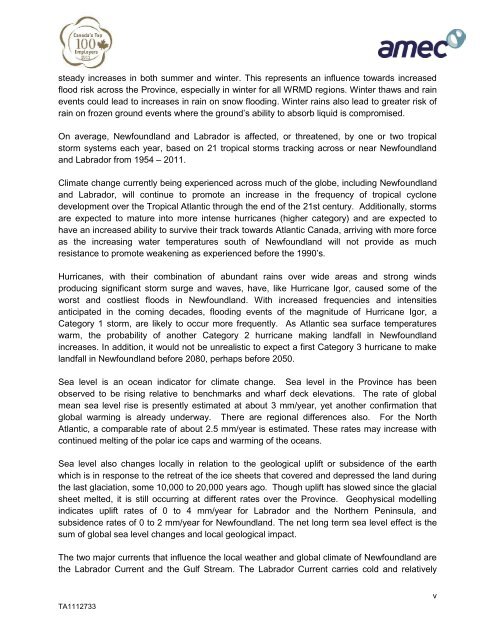Flood Risk and Vulnerability Analysis Project - Atlantic Climate ...
Flood Risk and Vulnerability Analysis Project - Atlantic Climate ...
Flood Risk and Vulnerability Analysis Project - Atlantic Climate ...
Create successful ePaper yourself
Turn your PDF publications into a flip-book with our unique Google optimized e-Paper software.
steady increases in both summer <strong>and</strong> winter. This represents an influence towards increased<br />
flood risk across the Province, especially in winter for all WRMD regions. Winter thaws <strong>and</strong> rain<br />
events could lead to increases in rain on snow flooding. Winter rains also lead to greater risk of<br />
rain on frozen ground events where the ground‟s ability to absorb liquid is compromised.<br />
On average, Newfoundl<strong>and</strong> <strong>and</strong> Labrador is affected, or threatened, by one or two tropical<br />
storm systems each year, based on 21 tropical storms tracking across or near Newfoundl<strong>and</strong><br />
<strong>and</strong> Labrador from 1954 – 2011.<br />
<strong>Climate</strong> change currently being experienced across much of the globe, including Newfoundl<strong>and</strong><br />
<strong>and</strong> Labrador, will continue to promote an increase in the frequency of tropical cyclone<br />
development over the Tropical <strong>Atlantic</strong> through the end of the 21st century. Additionally, storms<br />
are expected to mature into more intense hurricanes (higher category) <strong>and</strong> are expected to<br />
have an increased ability to survive their track towards <strong>Atlantic</strong> Canada, arriving with more force<br />
as the increasing water temperatures south of Newfoundl<strong>and</strong> will not provide as much<br />
resistance to promote weakening as experienced before the 1990‟s.<br />
Hurricanes, with their combination of abundant rains over wide areas <strong>and</strong> strong winds<br />
producing significant storm surge <strong>and</strong> waves, have, like Hurricane Igor, caused some of the<br />
worst <strong>and</strong> costliest floods in Newfoundl<strong>and</strong>. With increased frequencies <strong>and</strong> intensities<br />
anticipated in the coming decades, flooding events of the magnitude of Hurricane Igor, a<br />
Category 1 storm, are likely to occur more frequently. As <strong>Atlantic</strong> sea surface temperatures<br />
warm, the probability of another Category 2 hurricane making l<strong>and</strong>fall in Newfoundl<strong>and</strong><br />
increases. In addition, it would not be unrealistic to expect a first Category 3 hurricane to make<br />
l<strong>and</strong>fall in Newfoundl<strong>and</strong> before 2080, perhaps before 2050.<br />
Sea level is an ocean indicator for climate change. Sea level in the Province has been<br />
observed to be rising relative to benchmarks <strong>and</strong> wharf deck elevations. The rate of global<br />
mean sea level rise is presently estimated at about 3 mm/year, yet another confirmation that<br />
global warming is already underway. There are regional differences also. For the North<br />
<strong>Atlantic</strong>, a comparable rate of about 2.5 mm/year is estimated. These rates may increase with<br />
continued melting of the polar ice caps <strong>and</strong> warming of the oceans.<br />
Sea level also changes locally in relation to the geological uplift or subsidence of the earth<br />
which is in response to the retreat of the ice sheets that covered <strong>and</strong> depressed the l<strong>and</strong> during<br />
the last glaciation, some 10,000 to 20,000 years ago. Though uplift has slowed since the glacial<br />
sheet melted, it is still occurring at different rates over the Province. Geophysical modelling<br />
indicates uplift rates of 0 to 4 mm/year for Labrador <strong>and</strong> the Northern Peninsula, <strong>and</strong><br />
subsidence rates of 0 to 2 mm/year for Newfoundl<strong>and</strong>. The net long term sea level effect is the<br />
sum of global sea level changes <strong>and</strong> local geological impact.<br />
The two major currents that influence the local weather <strong>and</strong> global climate of Newfoundl<strong>and</strong> are<br />
the Labrador Current <strong>and</strong> the Gulf Stream. The Labrador Current carries cold <strong>and</strong> relatively<br />
TA1112733<br />
v














